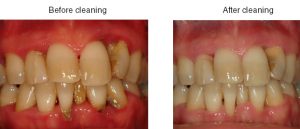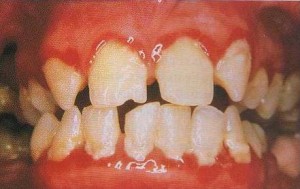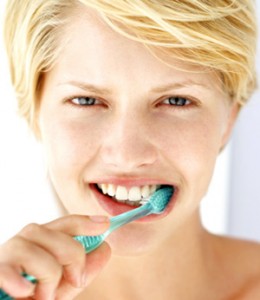Dental plaque is an adherent deposit of bacteria and their products, which forms on all tooth surfaces. The bacteria in teeth plaque react with foods we eat to produce acids that can attack and weaken tooth enamel (the hard, protective covering on our teeth), opening the way for cavities (dental caries) to develop as well as irritate the gums, leading to gum disease. Therefore it is important that plaque removal be done to keep our mouths healthy.
How does dental plaque form?
All bacteria that initiate plaque formation come in contact with the organically coated tooth surface by chance. Forces exist that tend to allow bacteria to accumulate on teeth or to remove them. Many factors influence the build-up of plaque, such as mechanical displacement, stagnation (for example colonization in a sheltered or undisturbed environment), and availability of nutrients.
Bacteria tend to be removed from the teeth during chewing of foods, by the tongue, toothbrushing, and other oral-hygiene activities. For this reason, bacteria tend to accumulate on teeth in sheltered, undisturbed environments (sites at risk), such as the fissures on the chewing surfaces of teeth, the surfaces below the contact between adjacent teeth, and in the gum sulcus.
Therefore, it is no coincidence that the major plaque-based dental diseases, cavities and inflammatory gum diseases, arise at these sites where plaque is most abundant and stagnant. Initial plaque formation may take as long as 2 hours. With the aid of nutrients from saliva and host food, the colonizing bacteria begin to multiply. About 2 days are then required for the plaque to double in mass, during which time, the bacterial colonies have been mixing together. The most dramatic change in bacterial numbers occurs during the first 4 or 5 days of plaque formation. After approximately 21 days, bacterial replication slows so that plaque accumulation becomes relatively stable.
The forming bacterial colonies are rapidly covered by saliva. In individuals with poor oral hygiene, superficial dental plaque on teeth may incorporate food debris and mammalian cells. This debris is called materia alba (literally, “white matter”). Unlike plaque, it is usually removed easily by rinsing with water.At times, the plaque demonstrates staining, with the discoloration being caused by sources including tea, heavy metal salts, drugs, and chromogenic (pigment-causing) bacteria.
How to remove plaque
In many cases, plaque is difficult for an individual to identify. This problem can be overcome, at least in the case of plaque located above the gum margins (supragingival plaque), by the use of disclosing agents, which are harmless dyes such as the red-staining agent, FD&C Red. The dyes may be in solution and painted on the teeth with a cotton applicator, or they may be tablets which are chewed, swished around the mouth, and then spit out. Once disclosed, most of the supragingival plaque and food debris can be easily removed by the daily use of a toothbrush, floss, and an irrigator.
Plaque can also be removed at planned intervals by the dental hygienist or a dentist as part of an oral prophylaxis. This is a procedure that has as its objective the mechanical removal of all soft and hard deposits (dental tartar), followed by a polishing of the tooth surfaces. However, because daily removal of the plaque is more effective, it is the individual – not the hygienist or the dentist – who is vital for preserving lifelong intact teeth.
One site where neither the dentist nor an individual can successfully remove dental plaque is in the depth of pits and fissures of chewing surfaces where the orifices are too small for the toothbrush bristle to penetrate. The flow of saliva or the muscular action of the cheeks and tongue also have little influence over the eventual development of cavities in these areas. Not coincidentally, the chewing surface is where the greatest percentage of cavities occurs. For this reason, it is recommended that all chewing surfaces with deep convoluted fissures be sealed with a pit-and-fissure dental sealant.
As soon as the plaque is removed from any surface of the tooth, it immediately begins to reform. This should not be unexpected, since by definition, dental plaque is composed of salivary residue, bacteria, and their end-products, all of which are always present in the mouth. Thus, a good plaque-control program must be continuous. It must be a daily commitment over a lifetime.
Frequency of dental plaque removal
The optimal frequency for mechanical plaque removal is not precisely known. It seems advisable to remove interproximal tooth plaque (plaque in between teeth) at least once every 24 hours for cavities prevention. Likewise, it had been suggested that those with an existing gingivitis or periodontitis should remove interproximal plaque on a daily basis. However, those with healthy gums may be able to practice interproximal plaque removal only once every 48 hours.
Therefore, with more daily attempts at plaque removal, it is more likely that the additive efforts will maximize the removal of plaque. Since the ideal frequency of interproximal plaque removal has not been shown, individual factors such as the amount of inflammation, cavities susceptibility, plaque removal efficiency, and accumulation and the capacity of a microorganism to cause disease of plaque must be considered in determining the frequency of plaque removal.



